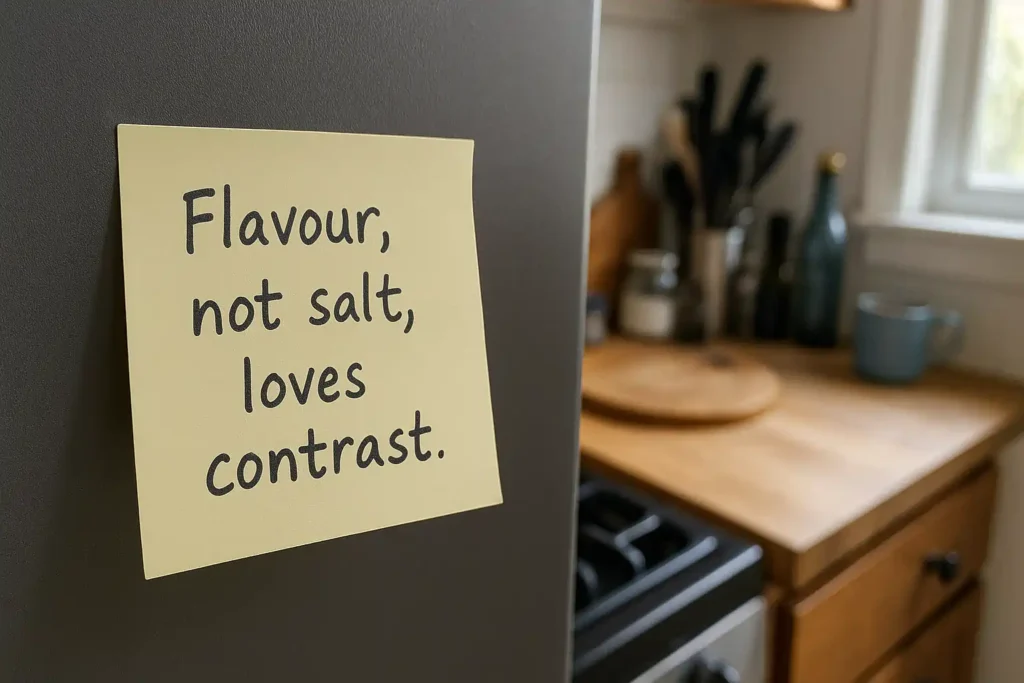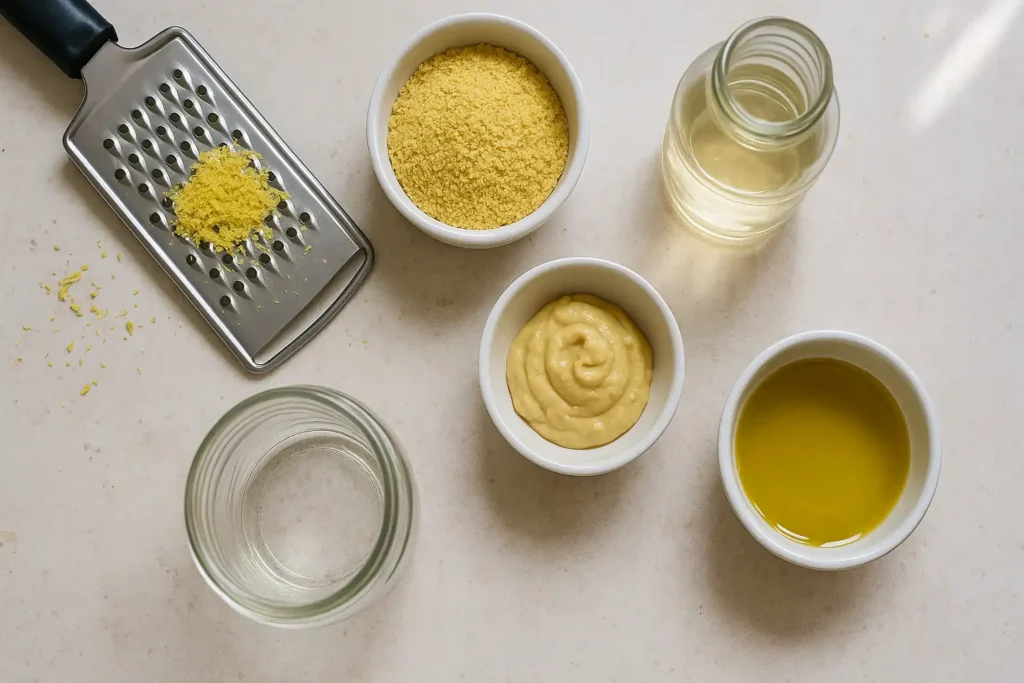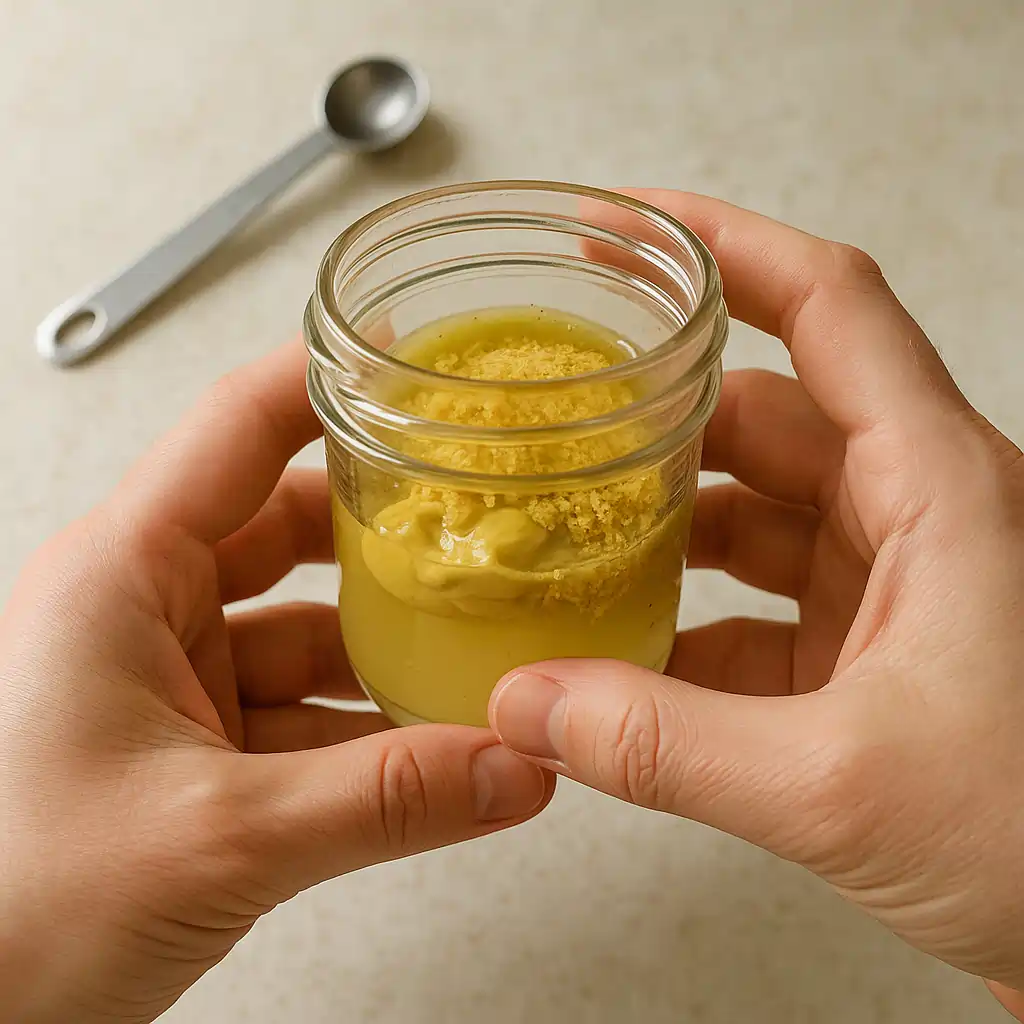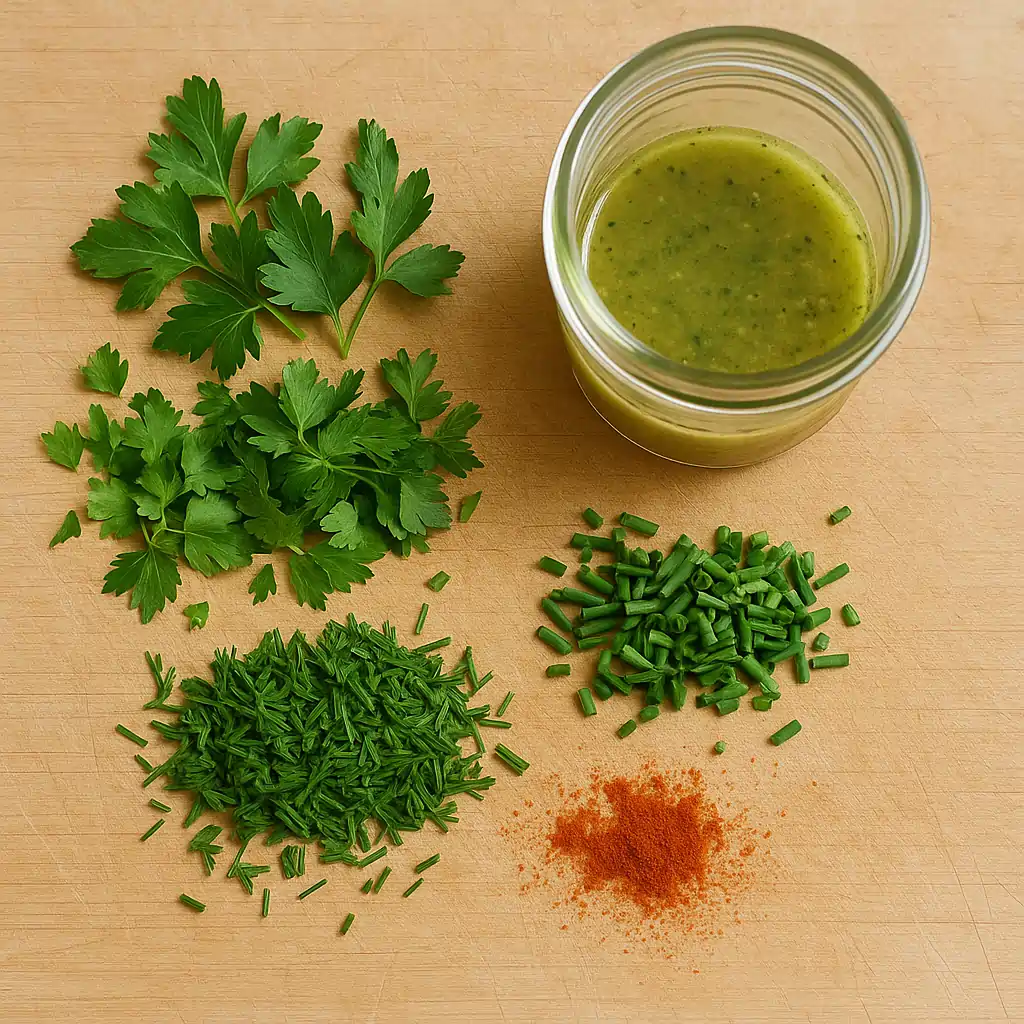“Flavour, not salt, loves contrast.” The day my friend who is a cardiologist made fun of me for having a heavy hand with the shaker, I wrote that on a sticky note, and sure enough, it stuck. Reducing sodium didn’t make my salads less delicious; on the contrary, it made me more adept at using acid, aromatics, and texture—and that’s where the magic happens. To avoid craving salt, the quick fix for a low-sodium salad dressing is to use a 2:1 ratio of oil to acid, thin with water, and then add lemon zest, vinegars, herbs, and umami.
If you’re looking at numbers, most people try to avoid taking more than 2,300 mg of sodium daily, and many people feel better when they take 1,500–2,000 mg, depending on their doctor’s advice. That will go away quickly if your dressing is
Because I increased the acid rather than balanced it, I went through a humble phase where everything tasted like lemon pledge. The solution involved adding a pinch of nutritional yeast for warm, cheesy depth, a tiny spoonful of low-sodium Dijon for body, and zest for aroma. I didn’t miss the salt at all when my “diet” dressing suddenly became the house favourite.
This recipe fits nicely into my larger guide at My Guide to Salad Dressing for cross-references, and I’ll direct you to Low FODMAP Salad Dressing (Garlic-Infused Oil, No Onion) and Italian Salad Dressing Mix (DIY Packet) for more in-depth information if you’re watching FODMAPs or enjoy Italian blends. This one will be quick, easy, and incredibly delicious.

Table of Contents
Table of Contents
Ingredients that add brightness, umami, and texture

When sodium backs off, brightness is your first line of defence. Greens are awakened by lemon and lime juice, but zest, which adds a bright scent without any additional acid or sodium, is the unsung hero. To prevent the oils from escaping, I grate the zest directly over the bowl. Occasionally, I combine a strip of zest with water and vinegar to create an upscale-tasting perfumed base.
By adding dimension, vinegars allow you to use less oil without feeling guilty. Apple cider vinegar is round and amiable, red wine vinegar keeps things traditional, and sherry vinegar adds a subtle nutty flavour that makes tomatoes taste like they’re in season. The mild, slightly sweet flavour of rice vinegar is ideal when omitting salt and don’t
The umami is where the majority of low-sodium dressings work or fail. A teaspoon or two of nutritional yeast blends in with the background, adding a nutty, Parmesan-like warmth that makes everything feel fuller. White miso is great, but it’s salty, so I use about a half teaspoon in the entire batch or use reduced-sodium miso, which adds a savoury backbone without making the numbers too high.
My go-to options if miso doesn’t feel right today are tomato paste, mushroom powder, or even a little pickle brine—basically vinegar plus aromatics—without salt. A small amount of roasted garlic paste also works well and lessens the need for salt because it is mild and sweet. Additionally, I added a thumb’s worth of grated shallot and left it in the acid for
Emulsifiers are useful because texture makes the dressing stick. While tahini or plain Greek yoghurt also add creaminess without being overly salty, low-sodium Dijon adds body without being overly salty. Since glossy means good coverage, I start by whisking a teaspoon of Dijon or tahini into the acid, then I pour in oil and a tablespoon or two of water until it becomes glossy.
Flavour confetti is fresh herbs. You can get a brightness that reads salty even when it’s not by simply chopping and adding parsley, dill, basil, and chives. Smoked paprika, chilli flakes, and black pepper add interest, and a final microdrizzling of fine olive oil completes it like a chef flex—which, okay, I do when people
Step-by-step (base recipe + pro fixes)

I start with a small jar because it makes cleanup simple and helps me be honest about portions. Three tablespoons of fresh lemon juice, one tablespoon of mild vinegar (such as rice or ACV), a teaspoon of low-sodium Dijon or a teaspoon of tahini for emulsification, and then I add lemon zest and a half teaspoon of nutritional yeast are all added to the jar. Since clumpy mustard is depressing, I shake that first to get everything to dissolve.
Next After adding two tablespoons of cold water and six tablespoons of extra-virgin olive oil, I shake vigorously for at least twenty seconds. Here, the water serves two purposes: it thins the calories and tightens the texture, allowing the dressing to stick to the lettuce rather than pool. I add black pepper and take a whiff.
Since spoons lie and greens alter the atmosphere, I live by the maxim “taste on a leaf.” I add another tablespoon of water or a tiny drizzle of maple if it’s too sharp, but I don’t freak out because it usually only takes a little prodding to get the balance right. I add a pinch of nutritional yeast or another squeeze of lemon if it feels flat, and the depth immediately becomes apparent.
Use an immersion blender to pulverise everything for 10 seconds if you want an extremely smooth version. Yes, the colour becomes a little hazy, which is a positive sign, but that tiny bit of shear locks in the emulsion and it will hold for days. When I’m feeling particularly generous, I add a teaspoon of roasted red pepper for sweetness and colour, which
Fixing common oops moments is simple. One to two tablespoons of water and another shake, rather than more acid, immediately cures an oily mouthfeel. Since thickening takes a minute to manifest and patience is, in fact, the key ingredient, thin and watery recipes receive a half teaspoon more Dijon or tahini and a rest.
Toss the greens with a little bit of the dressing first, then add the crunchy vegetables and proteins, and finally finish with more dressing if you’re assembling a full salad. Because the leaves are shielded by that initial whisper coat, you’ll use fewer calories and sodium overall. After soaking a beautiful bowl and then, uh, attempting to un-wet lettuce—which is impossible—I discovered that one.
Low Sodium Salad Dressing
Equipment
- small jar with lid For shaking and storing
- Microplane or zester For lemon zest
- measuring spoons
- Whisk (optional) Use if not shaking in jar
Ingredients
- 3 tbsp fresh lemon juice
- 1 tbsp mild vinegar (rice or apple cider)
- 1 tsp low-sodium Dijon mustard or tahini
- 1 tsp lemon zest (grated directly over jar)
- 1/2 tsp nutritional yeast
- 2 tbsp cold water
- 6 tbsp extra-virgin olive oil
- 1 pinch black pepper (to taste)
Instructions
- In a jar, combine lemon juice, vinegar, Dijon or tahini, lemon zest, and nutritional yeast. Shake or whisk to dissolve.
- Add cold water and olive oil. Seal and shake vigorously for 20 seconds until emulsified and slightly cloudy.
- Taste on salad greens. Adjust with water if too sharp, or add a squeeze of lemon for lift. Add pepper to taste.
- Store in fridge up to 1–2 weeks. Shake before each use. If oil firms up, let rest at room temp or run under warm water.
Notes
- Use lemon zest, vinegar, and herbs to lift flavor.
- Nutritional yeast adds depth, Dijon or tahini gives body.
- Taste on greens, not a spoon. Water thins and balances without extra oil.
- Avoid garlic-heavy batches for longer storage.
Variations: Italian, creamy yogurt, and balsamic

Italian cuisine is ideal for avoiding salt and relies heavily on oregano, garlic, and red wine vinegar. Instead of using lemon juice, I use two tablespoons of red wine vinegar and one tablespoon of lemon. I then whisk in a teaspoon of low-sodium Dijon, a pinch of dried oregano, and a micro pinch of garlic powder, or grated fresh if you can handle it. It tastes like pizza night without the guilt, and I finish with chopped parsley and a little water to keep it light. The amount of olive oil stays at six tablespoons.
I’ll add a quarter teaspoon of crushed fennel seed, which makes tomatoes sing, for a cosy twist. For busy weeks, combine the dried herbs in a small jar of /italian-salad-dressing-mix/ for a shelf-friendly shortcut.
Creamy yoghurt is low in sodium and feels like ranch’s more subdued cousin. To keep it silky, I use a third cup of plain Greek yoghurt, two tablespoons of lemon juice, one tablespoon of water, a teaspoon of oil infused with garlic, and a tablespoon of chopped dill and chives. I also whisk in two tablespoons of olive oil. It complements grilled chicken or chickpeas and has a bright, thick flavour that clings to crunchy romaine.
A similar texture with monounsaturated fat can be achieved with mashed avocado, lemon, and water if dairy is not your thing. When yoghurt isn’t available, I’ve also made a tahini-lemon riff with parsley and cumin, which is surprisingly ranch-adjacent and salt-free. Thinning to the precise pour you desire and then tasting on a leaf—always that—is the trick.
You won’t miss the shaker thanks to the natural sweetness that balsamic adds. I use six tablespoons of olive oil, two tablespoons of water, one tablespoon of lemon, three tablespoons of balsamic, and a teaspoon of low-sodium Dijon. For a final touch, I add a teaspoon of nutritional yeast. If you like multipurpose sauces, it also works well as a marinade and tastes amazing on spinach with walnuts and strawberries.
I’ll add a tiny roasted garlic clove to the balsamic version and smile like I’m getting away with something on nights when I’d rather have romance than health. If you add some cracked pepper at the table, it feels like a bistro moment and reads richer than it actually is. When the salad tastes like that, no one inquires about sodium, and that is the main goal.
Storage
These kinds of vinaigrettes, particularly the lemon and Italian varieties, are best kept in the refrigerator and remain lively for one to two weeks. I actually write the date on the lid and stick to it because dairy and fresh herbs get tired and the creamy yoghurt riff is best within three to five days. It’s normal to see separation, and a firm shake will immediately resolve the issue.
I leave the jar out while I chop vegetables or run it under lukewarm water for a minute because olive oil can solidify when it gets cold. I try not to microwave because hot spots can split the emulsion and dull its flavour, and I really don’t enjoy saving broken dressings. If in doubt, make a smaller batch and savour it while it’s still fresh, as two minutes of shaking is preferable to discarding a scientific experiment.
Anything that contains dairy or fresh garlic should always be kept in the refrigerator for food safety reasons. Anything that wears a fuzzy hat, smells bad, or appears fizzy is definitely out. Greens deserve better, so now instead of gambling and regretting it, I just start a new jar and move on.
Nutrition panel (base vinaigrette, per 2 Tbsp serving, estimate)
This is for the basic lemon vinaigrette, which is made with water, olive oil, nutritional yeast, and low-sodium Dijon. Depending on how yeasty you go, a serving has about 90–110 calories, 10–11 g fat, 1 g carbs, and 0–1 g protein. For the majority of people, sodium levels fall comfortably within the low-sodium range of 35 to 70 mg per serving as written.
If you substitute low-sodium Dijon or tahini, the sodium content remains the same, but the creamy yoghurt version slightly reduces calories and increases protein. Because the acid adds so much flavour that you don’t need to chase salt, the balsamic riff adds a little more natural sugars while typically keeping sodium in the same lane. Adapt ingredients and portions to your goals and label data; these are home cook estimates, not medical advice.
Put your exact brands into a calculator and measure by weight for the most accurate results if you’re keeping a close eye on things. To avoid having to think about it in the middle of the week, I write “~60 mg Na / 2 Tbsp” on the lid after doing this for new batches. It’s nerdy, but it keeps me honest when the salad looks particularly appetising.
Wrap-up
I will die on that hill with a lemon zester in my hand, and low sodium does not equate to low joy. A low-salinity salad dressing can carry dinner when it combines acid, zest, herbs, umami, and the proper texture. You’ll be set after starting with the 2:1 base, thinning it with water, making minor adjustments, and tasting it.
For more tips and ratio knowledge, visit the main hub at /salad-dressing/ if you want to venture out. When you’re cutting back on sweeteners, pair this with /sugar-free-salad-dressing/. For incredibly quick preparation, get the herb blend at /italian-salad-dressing-mix/. If you’re sensitive to garlic and onions, don’t worry—for a simple swap map, visit /low-fodmap-salad-dressing/.
We learn more quickly together, so tell me how you riffed it and what completely slapped or flopped. If you make a jar today, label it and take a victory bite—that’s a small victory worth celebrating. Share your adjustments in the comments section. You give a high five to both your taste buds and your heart.
